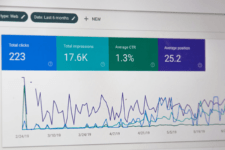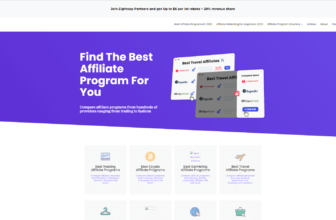
How to Use SEO to Boost Your Affiliate Marketing Sales
Introduction
Affiliate marketing can be a lucrative way to monetize your blog and earn passive income. However, with so many bloggers and websites competing for attention, it can be difficult to stand out and attract traffic to your affiliate links. That’s where SEO comes in.
Search engine optimization, or SEO, is the practice of optimising your website and content to improve your visibility in search engines like Google or Bing. By optimising your blog for SEO, you can increase your chances of ranking higher in search engine results pages, which can drive more traffic to your blog and ultimately boost your affiliate marketing sales.
In this article, we’ll cover some of the best practices for using SEO to boost your affiliate marketing sales. From conducting keyword research to building high-quality backlinks, we’ll explore the essential steps you need to take to optimise your blog for SEO and succeed in your affiliate marketing efforts. So let’s get started! SEO for startups can also be hugely beneficial.
Conduct Keyword Research
If you want to boost your affiliate marketing sales, then it’s essential to understand the importance of conducting keyword research. Keyword research is the process of identifying the specific words and phrases that people use to search for products, services, or information related to your niche. By using the right keywords in your content, you can improve your website’s visibility and attract more traffic from search engines.
The first step in conducting keyword research is to identify the primary topics or themes that are relevant to your niche. For example, if you’re promoting health and fitness products as an affiliate marketer, you might start with topics like weight loss, muscle building, or nutrition. Once you have a list of broad topics, you can use keyword research tools to find more specific keywords that are related to those topics.
One of the most popular keyword research tools is Google Keyword Planner. This free tool allows you to enter a keyword or topic and generate a list of related keywords along with their search volume and competition level. You can also filter the results by location and language to target specific audiences.
Another useful tool for keyword research is Ahrefs Keyword Explorer. This tool provides more in-depth keyword data, including search volume, keyword difficulty, and the top-ranking pages for each keyword. You can use this information to identify keywords with high search volume and low competition, which are easier to rank for in search engine results pages (SERPs).
Once you have a list of potential keywords, it’s essential to evaluate their relevance to your niche and your target audience. You want to choose keywords that accurately describe your content and attract the right kind of traffic. For example, if you’re promoting vegan protein supplements, you might want to avoid keywords like “whey protein” or “meat-based protein” because they’re not relevant to your niche. Instead, you might use keywords like “plant-based protein” or “vegan protein powder” to target your audience.
Another factor to consider when evaluating keywords is search intent. Search intent refers to the reason behind a user’s search query. For example, someone searching for “best protein powder” might be looking for product reviews or comparisons, while someone searching for “how to build muscle” might be looking for workout tips or training programs. By understanding the search intent behind different keywords, you can create content that meets the needs of your audience and provides value.
Once you’ve identified the most relevant and valuable keywords for your niche, it’s time to start incorporating them into your content. You can use keywords in a variety of ways, including:
- Titles and Headlines – Use your primary keywords in your blog post titles, article headlines, and meta descriptions to make your content more discoverable in search results.
- Body Text – Incorporate your keywords naturally into your content, making sure to avoid keyword stuffing, which can hurt your rankings.
- Image Alt Tags – Use descriptive keywords in your image alt tags to make your images more discoverable in search results.
- URLs – Use relevant keywords in your URLs to make them more user-friendly and improve your chances of ranking higher in search results.
- Meta Tags – Use your keywords in your meta tags, including the meta title and meta description, to provide additional context for search engines and users.
It’s also essential to monitor your keyword performance regularly to see which keywords are driving the most traffic and conversions. You can use tools like Google Analytics or Ahrefs to track your keyword rankings and monitor your website’s performance. By analysing this data, you can identify opportunities to optimise your content further and improve your SEO strategy.
Optimise Your Website for SEO
Optimising your website for SEO is crucial if you want to boost your affiliate marketing sales. SEO, or search engine optimization, refers to the techniques and strategies that help your website rank higher in search engine results pages (SERPs). By optimising your website for SEO, you can attract more traffic from search engines, improve your website’s visibility, and increase your chances of converting visitors into customers. To do this, you can always get in touch with a reputable agency like Four Dots, who can assist you in creating and putting into practice a successful SEO strategy.
The first step in optimising your website for SEO is to ensure that your website is user-friendly and easy to navigate. Your website should have a clear and intuitive layout, with easy-to-read content and clear calls-to-action. You should also make sure that your website loads quickly and is optimised for mobile devices, as more and more users are accessing the internet on their smartphones and tablets.
Another important aspect of website optimization is on-page optimization. On-page optimization refers to the techniques and strategies that you can use to improve the content and structure of your website pages. Some of the key on-page optimization techniques include:
- Keyword optimization – As mentioned in the previous section, keyword research is essential for identifying the keywords that your target audience is using to search for products or services related to your niche. Once you have identified these keywords, you should use them strategically throughout your website content to improve your chances of ranking higher in search engine results pages.
- Title tags and meta descriptions – Title tags and meta descriptions are the snippets of text that appear in search engine results pages. They provide users with a brief summary of what your website is about and why they should click on your link. Optimising your title tags and meta descriptions with relevant keywords can help improve your click-through rates and attract more traffic to your website.
- Header tags – Header tags (H1, H2, H3, etc.) are used to organise and structure your website content. Using header tags can help improve the readability of your content and make it easier for search engines to understand the structure of your website.
- Image optimization – Optimising your website images can help improve your website’s load times and make your website more user-friendly. You can optimise your images by compressing them, using descriptive file names, and adding alt text tags that describe the contents of the image.
- Internal linking – Internal linking refers to the practice of linking to other pages within your website. By linking to relevant pages within your website, you can improve the user experience and help search engines understand the structure of your website.
Another important aspect of website optimization is off-page optimization. Off-page optimization refers to the techniques and strategies that you can use to improve your website’s authority and reputation online. Some of the key off-page optimization techniques include:
- Link building – Link building refers to the practice of acquiring links from other websites. Links from high-quality, authoritative websites can help improve your website’s authority and reputation, which can in turn improve your search engine rankings.
- Social media marketing – Social media marketing can help increase your website’s visibility and attract more traffic to your website. By sharing your website content on social media platforms like Facebook, Twitter, and Instagram, you can reach a wider audience and attract more potential customers.
- Influencer marketing – Influencer marketing involves partnering with influencers in your niche to promote your products or services. By working with influencers who have a large and engaged audience, you can increase your website’s visibility and attract more traffic to your website.
Content marketing – Content marketing involves creating high-quality, informative content that provides value to your target audience. By creating content that is optimised for SEO and that addresses the needs and interests of your target audience, you can attract more traffic to your website and improve your search engine rankings.
Create High-Quality Content
Creating high-quality content is crucial if you want to attract more traffic to your website and improve your search engine rankings. High-quality content is content that provides value to your target audience, is well-written, and is optimised for search engines. In this section, we will discuss some of the key strategies that you can use to create high-quality content that is optimised for SEO.
- Conduct keyword research – Keyword research is the process of identifying the keywords and phrases that your target audience is using to search for products or services related to your niche. By conducting keyword research, you can identify the keywords that are most relevant to your target audience and optimise your content accordingly.
- Write informative and engaging content – Your content should be informative and engaging, and should provide value to your target audience. You should aim to answer the questions and address the concerns of your target audience, and provide them with useful information that they can use to make informed decisions.
- Use headings and subheadings – Headings and subheadings can help break up your content into smaller, more manageable sections, and can make your content easier to read and understand. You should use headings and subheadings to organise your content and make it more user-friendly.
- Use images and videos – Images and videos can help make your content more engaging and visually appealing. You should use high-quality images and videos that are relevant to your content, and that help illustrate your points.
- Optimise your content for search engines – You should optimise your content for search engines by using relevant keywords and phrases throughout your content. You should also use title tags, meta descriptions, and alt text tags to provide search engines with more information about your content.
- Use internal linking – Internal linking refers to the practice of linking to other pages within your website. By using internal linking, you can help users navigate your website more easily, and can also help search engines understand the structure of your website.
- Use external linking – External linking refers to the practice of linking to other websites from your content. By linking to high-quality, authoritative websites, you can improve the credibility of your content, and can also improve your search engine rankings.
- Update your content regularly – You should aim to update your content regularly, and to provide fresh, new content that is relevant to your target audience. By updating your content regularly, you can attract more traffic to your website, and can also improve your search engine rankings.
- Use social media – Social media can be a powerful tool for promoting your content and attracting more traffic to your website. You should share your content on social media platforms like Facebook, Twitter, and LinkedIn, and should also engage with your followers and respond to their comments and questions.
- Use email marketing – Email marketing can be a great way to promote your content and attract more traffic to your website. You should use email marketing to promote your content to your subscribers, and to encourage them to share your content with their friends and followers.
Build High-Quality Backlinks
When it comes to SEO, building high-quality backlinks is one of the most important factors for improving your search engine rankings and driving traffic to your website. Backlinks are links from other websites that point to your website, and they are seen as a vote of confidence from those websites. In this section, we will discuss some key strategies you can use to build high-quality backlinks that will help you boost your affiliate marketing sales.
- Create high-quality content – The first step to building high-quality backlinks is to create high-quality content. When your content is valuable and informative, other websites are more likely to link to it. This is why it’s important to focus on creating content that is well-researched, accurate, and up-to-date. Use tools like Ahrefs or Moz to identify content gaps in your niche and create content that fills those gaps.
- Use guest blogging – Guest blogging is a popular strategy for building high-quality backlinks. When you write a guest post for another website, you can include a link back to your website in your author bio or within the content itself. Look for websites in your niche that accept guest posts and pitch them your ideas. Make sure your guest post is well-written and provides value to their audience.
- Reach out to influencers – Influencer outreach is another effective way to build high-quality backlinks. Identify influencers in your niche and reach out to them via email or social media. Introduce yourself and your website, and ask if they would be interested in linking to your content. Make sure your outreach is personalised and provides value to the influencer’s audience.
- Use broken link building – Broken link building is a strategy that involves finding broken links on other websites and offering your content as a replacement. Use tools like Ahrefs or Broken Link Checker to find broken links in your niche, and create content that is a suitable replacement for the broken link. Then, reach out to the website owner and offer your content as a replacement.
- Participate in online communities – Online communities like forums and social media groups are a great way to connect with other website owners in your niche. Participate in these communities and offer your expertise and insights. When appropriate, include a link back to your website in your comments or posts. Just make sure you’re not spamming or self-promoting excessively.
- Use infographics – Infographics are a popular type of content that are highly shareable and linkable. Create high-quality infographics that provide value to your audience, and promote them on social media and other online platforms. Infographics are more likely to be shared and linked to than other types of content, so they can be a great way to build high-quality backlinks.
- Use directory submissions – Directory submissions can be an effective way to build backlinks, especially for local SEO. Submit your website to relevant directories in your niche or location, and make sure your information is accurate and up-to-date. Avoid spammy directories or directories that are not relevant to your niche.
- Offer testimonials – Testimonials are a great way to establish your credibility and build relationships with other website owners. When you use a product or service that you’re happy with, offer to provide a testimonial for the website owner. Make sure your testimonial is genuine and provides value to their website, and include a link back to your website in your author bio.
- Use social media – Social media can be a powerful tool for building high-quality backlinks. Share your content on social media platforms like Twitter, Facebook, and LinkedIn, and engage with your audience by responding to comments and questions. When appropriate, include a link back to your website in your posts or comments.
- Monitoring backlinks is important for several reasons when it comes to blogging and SEO. Backlinks are links from other websites that point to your blog, and they can have a significant impact on your search engine rankings and overall online visibility.
Track Your Results and Make Improvements
After implementing the strategies discussed in the previous sections, it’s important to track your results and make improvements to your SEO strategy. Tracking your results allows you to see what’s working and what’s not, so you can make informed decisions about how to improve your SEO efforts. In this section, we’ll discuss some key metrics to track and how to make improvements based on your results.
- Track your keyword rankings – Keyword rankings are a key metric to track when it comes to SEO. Use a tool like Ahrefs or SEMrush to track your keyword rankings over time. Look for keywords that are driving traffic to your website and focus on optimising your content and backlinks for those keywords. If you notice a decline in your rankings for a particular keyword, it may be time to re-evaluate your strategy for that keyword.
- Monitor your traffic and engagement – Traffic and engagement metrics are also important to track when it comes to SEO. Use tools like Google Analytics to monitor your website traffic and engagement metrics like bounce rate, time on site, and pages per session. Look for trends over time and identify areas where you can make improvements to your website or content to increase engagement and keep visitors on your site for longer.
- Monitor your backlinks – As we discussed in the previous section, building high-quality backlinks is an important part of any SEO strategy. Use a tool like Ahrefs to monitor your backlinks over time. Look for trends in the number and quality of your backlinks, and identify areas where you can make improvements. For example, if you notice that your backlinks are coming from low-quality websites, it may be time to re-evaluate your outreach strategy.
- Make improvements based on your results – Once you’ve tracked your results and identified areas for improvement, it’s time to take action. Use your data to inform your SEO strategy and make improvements where needed. For example, if you notice that your bounce rate is high, it may be time to improve your website design or navigation. If you notice that your backlinks are coming from low-quality websites, it may be time to re-evaluate your outreach strategy and focus on building relationships with high-quality websites in your niche.
Stay up-to-date with SEO trends and best practices – SEO is constantly evolving, so it’s important to stay up-to-date with the latest trends and best practices. Subscribe to industry blogs and newsletters, attend webinars and conferences, and participate in online communities to stay informed about the latest SEO strategies and techniques. Implementing these strategies can help you stay ahead of the curve and improve your SEO results over time.
Conclusion
In conclusion, optimising your blog for SEO is an essential part of any successful affiliate marketing strategy. By conducting thorough keyword research, optimising your website for SEO, creating high-quality content, building high-quality backlinks, and tracking your results and making improvements, you can increase your blog’s visibility in search engines and drive more traffic and sales from your affiliate marketing efforts.
Remember that SEO is an ongoing process, and it takes time and effort to see results. However, by following these best practices and staying up to date with the latest SEO trends and strategies, you can create a strong and effective SEO strategy for your blog and see long-term success in your affiliate marketing efforts.
So don’t hesitate to get started with SEO for your blog today. With the right approach and a commitment to continuous improvement, you can take your affiliate marketing sales to the next level and achieve your goals as a blogger and affiliate marketer.
- Affiliate Review of VOdds: How to Make Money on Affiliate Sports Betting - 4 October 2024
- Earn with the LEGO Affiliate Program: UK Edition - 6 August 2024
- A Full Guide to The Adidas Affiliate Program - 23 July 2024









Wonderful blog! I found it while surfing around on Yahoo News. Do you have any tips on how to get listed in Yahoo News? I’ve been trying for a while but I never seem to get there! Cheers
I got what you mean ,saved to my bookmarks, very decent internet site.
Woh I enjoy your posts, saved to bookmarks! .